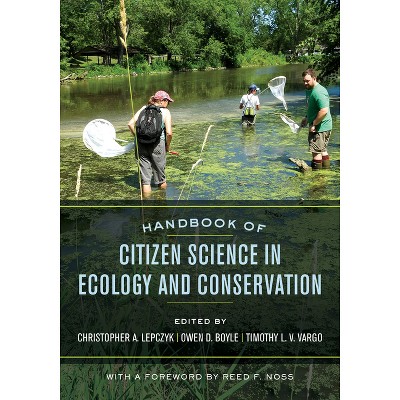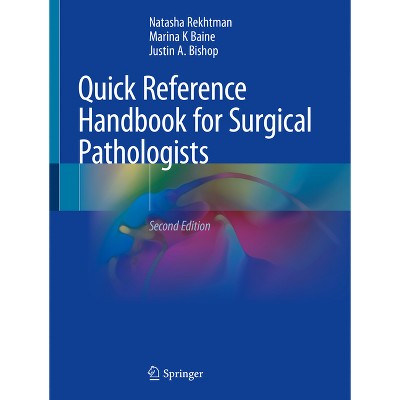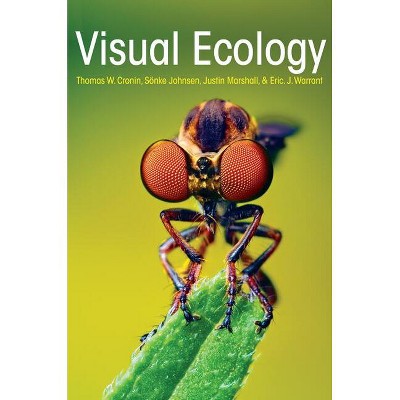Sponsored

Handbook of Quantitative Ecology - by Justin Kitzes (Paperback)
$25.00
In Stock
Eligible for registries and wish lists
Sponsored
About this item
Highlights
- An essential guide to quantitative research methods in ecology and conservation biology, accessible for even the most math-averse student or professional.
- About the Author: Justin Kitzes is assistant professor of biological sciences at the University of Pittsburgh.
- 176 Pages
- Nature, Ecology
Description
About the Book
"Students and other researchers entering the fields of ecology and conservation biology often come with little computational or mathematics training, leaving them feeling unprepared to participate in the quantitative aspects of research in these fields. In this "low threshold, high ceiling" introduction to the subject, Justin Kitzes, an ecologist who has taught students at both undergraduate and graduate levels, aims to remedy this situation. He argues that anyone with the ability and interest to study ecology can learn the basics of the most widely used methods in quantitative ecology. Specifically, Kitzes shows readers how to translate common biological questions into mathematical models, doing so using only basic algebra and the use of spreadsheets, without requiring any background in advanced mathematics or programming skills. Students and practicing conservation biologists who are mathematically out-of-practice or uncomfortable will find this book a useful and necessary resource"--Book Synopsis
An essential guide to quantitative research methods in ecology and conservation biology, accessible for even the most math-averse student or professional. Quantitative research techniques have become increasingly important in ecology and conservation biology, but the sheer breadth of methods that must be understood-from population modeling and probabilistic thinking to modern statistics, simulation, and data science-and a lack of computational or mathematics training have hindered quantitative literacy in these fields. In this book, ecologist Justin Kitzes addresses those challenges for students and practicing scientists alike. Requiring only basic algebra and the ability to use a spreadsheet, Handbook of Quantitative Ecology is designed to provide a practical, intuitive, and integrated introduction to widely used quantitative methods. Kitzes builds each chapter around a specific ecological problem and arrives, step by step, at a general principle through the process of solving that problem. Grouped into five broad categories-difference equations, probability, matrix models, likelihood statistics, and other numerical methods-the book introduces basic concepts, starting with exponential and logistic growth, and helps readers to understand the field's more advanced subjects, such as bootstrapping, stochastic optimization, and cellular automata. Complete with online solutions to all numerical problems, Kitzes's Handbook of Quantitative Ecology is an ideal coursebook for both undergraduate and graduate students of ecology, as well as a useful and necessary resource for mathematically out-of-practice scientists.Review Quotes
"Handbook of Quantitative Ecology is most valuable. The book clearly, briefly, and gently introduces readers to many quantitative approaches one can find used in ecology today. . . . This book can (and should) be given to the enthusiastic undergraduate with an interest in ecology, the master's or PhD student with little to no mathematical training, or a professor looking to develop or reshape a course in quantitative biology. The author beautifully illustrates how effective quantitative analysis can be for solving ecological questions."-- "Quarterly Review of Biology"
"Quantitative ecology is the application of mathematical modeling and probability theory to ecological concepts. Kitzes provides a short introduction to the quantitative methods most relevant to an introductory undergraduate course in ecology. In addition to short chapters introducing the methods of quantitative ecology, 20 chapters each present a simple example that can be studied through a quantitative method. Each chapter extends to four or five pages. After presenting the chapter's problem, the appropriate mathematical method is explained. Kitzes presents readers with specific instructions on setting up the mathematical model in a spreadsheet. His writing style is very clear, employing only minimal jargon. The mathematics is limited to algebra, presenting a low barrier to students without much mathematical background. The methods include difference equations, probability, matrix models, and several others. . . . Recommended."-- "Choice"
"A low-threshold, high-ceiling introduction. Kitzes's book will appeal to undergraduate and graduate students who wish to increase their quantitative understanding to be able to better engage with the literature (which has grown increasingly quantitative) and take the first step--a large leap, in fact--toward becoming practitioners of quantitative ecology."--Andrew Rominger, University of Maine
"A stroke of genius. Kitzes does an excellent job of translating the properties of biological systems into mathematical models, using basic logic and without any advanced math. His approach is a powerful way to demystify these models and make them intuitive."--Corlett Wolfe Wood, University of Pennsylvania
About the Author
Justin Kitzes is assistant professor of biological sciences at the University of Pittsburgh. He is coeditor of The Practice of Reproducible Research: Case Studies and Lessons from the Data-Intensive SciencesDimensions (Overall): 9.0 Inches (H) x 6.0 Inches (W) x .4 Inches (D)
Weight: .58 Pounds
Suggested Age: 22 Years and Up
Number of Pages: 176
Genre: Nature
Sub-Genre: Ecology
Publisher: University of Chicago Press
Format: Paperback
Author: Justin Kitzes
Language: English
Street Date: July 20, 2022
TCIN: 1006098534
UPC: 9780226818344
Item Number (DPCI): 247-44-6946
Origin: Made in the USA or Imported
If the item details aren’t accurate or complete, we want to know about it.
Shipping details
Estimated ship dimensions: 0.4 inches length x 6 inches width x 9 inches height
Estimated ship weight: 0.58 pounds
We regret that this item cannot be shipped to PO Boxes.
This item cannot be shipped to the following locations: American Samoa (see also separate entry under AS), Guam (see also separate entry under GU), Northern Mariana Islands, Puerto Rico (see also separate entry under PR), United States Minor Outlying Islands, Virgin Islands, U.S., APO/FPO
Return details
This item can be returned to any Target store or Target.com.
This item must be returned within 90 days of the date it was purchased in store, shipped, delivered by a Shipt shopper, or made ready for pickup.
See the return policy for complete information.











